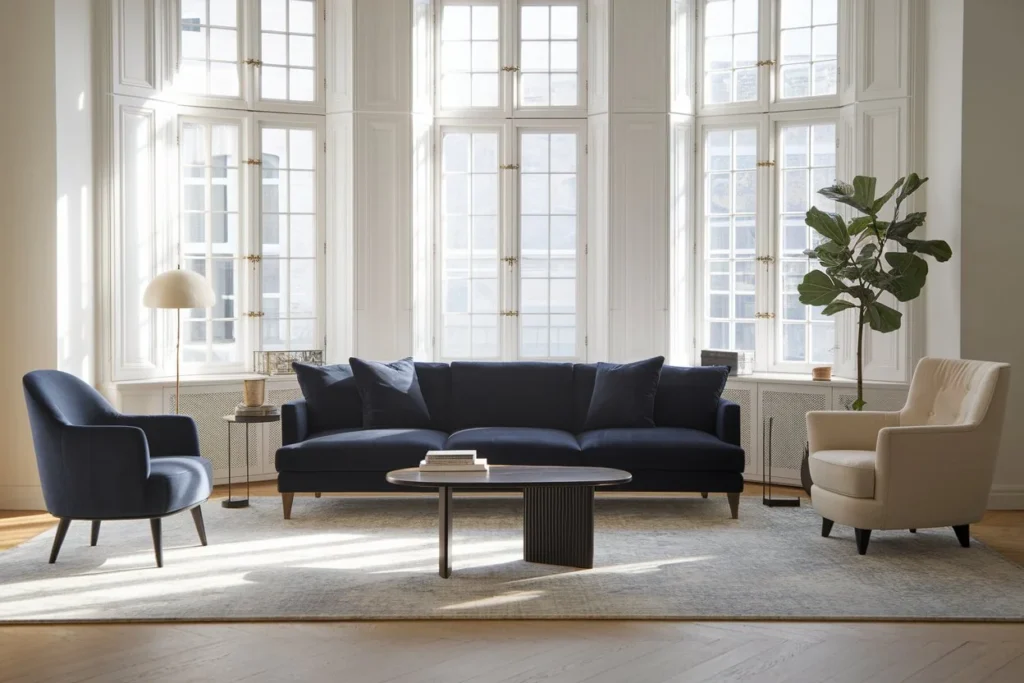Ever walked into a room that just felt “right” but couldn’t explain why?
Or struggled with furniture placement that never quite looks as polished as those magazine spreads?
The secret might be simpler than you think. It is called the Rule of Thirds, and it is about to become your new best friend in home design.
What is the Rule of Thirds in Interior Design?
The Rule of Thirds is a fundamental principle that divides any space into a 3×3 grid, creating nine equal sections. Professional designers use this invisible grid to create balanced, visually appealing spaces that feel naturally harmonious. The best part? You don’t need an expensive design degree to master it.
15 Professional Tips to Apply the Rule of Thirds
Following are the 15 professional tips that you should keep in mind during your home decor and interior design process:
1. Create the Perfect Seating Arrangement
Instead of pushing your sofa against the wall, try placing it about one-third into the room. This creates a more dynamic space and improves conversation flow. Position accent chairs at intersecting grid points to achieve visual balance.
2. Master Your Wall Art Placement
Hang artwork at eye level, approximately one-third down from the ceiling. When grouping pieces, arrange them so key elements align with your imaginary grid’s intersection points. This creates a gallery-worthy display that draws the eye naturally through the space.
3. Design Window Treatments That Wow
Install curtain rods one-third down from the ceiling instead of just above the window frame. This simple adjustment makes your windows appear taller and your room more luxurious.
4. Balance Your Color Palette
Apply the 60-30-10 rule: use your primary color in about 60% of the space (walls and large furniture), a secondary color in 30% (accent furniture and textiles), and an accent color in 10% (accessories and art).
5. Structure Your Shelving Display
Divide your bookshelf into thirds both horizontally and vertically. Place larger items at the intersection points and create visual breathing space between groupings.
6. Layout Your Area Rugs
Position your area rug so it extends about one-third under major furniture pieces. This creates a cohesive look while maintaining proper proportions.
7. Transform Your Table Arrangements
When styling coffee tables or consoles, divide the surface into thirds and create vignettes at the intersection points, leaving some areas intentionally empty for balance.
8. Perfect Your Lighting Scheme
Position floor lamps at third-points in the room, and ensure table lamps are placed at varying heights that correspond to your grid’s intersections.
9. Arrange Throw Pillows Like a Pro
Group pillows in threes, varying their sizes and patterns while maintaining your color scheme. Position them asymmetrically for a casual, lived-in look.
10. Create Focal Points That Command Attention
Position your room’s main focal point (fireplace, TV, or statement piece) at a third-point rather than centered, then arrange furniture to complement this placement.
11. Design Multi-Functional Spaces
Divide open-concept areas into thirds to create distinct zones for different activities while maintaining visual flow.
12. Layer Your Lighting
Install lighting at three different heights: floor level, table height, and ceiling, creating depth and ambiance.
13. Structure Your Kitchen Work Triangle
Apply the Rule of Thirds to optimize your kitchen’s work triangle, positioning the sink, stove, and refrigerator at grid intersections for optimal flow.
14. Balance Your Bedroom Layout
Position your bed so it occupies one-third of the room’s width, leaving equal space on either side for nightstands and walking areas.
15. Optimize Small Spaces
Even in compact rooms, use the Rule of Thirds to create zones for different activities, making the space feel larger and more organized.
Budget-Friendly Implementation Tips
– Use painter’s tape to temporarily mark your thirds on walls before hanging art
– Rearrange existing furniture to align with grid intersections
– Create DIY art pieces sized according to the Rule of Thirds
– Use mirrors strategically at intersection points to amplify light and space
– Group accessories in threes for instant designer appeal
Common Mistakes to Avoid
1. Don’t force perfect symmetry – the Rule of Thirds actually works best with slight asymmetry
2. Avoid centering everything – this can make a room feel static
3. Don’t forget about vertical space – apply the rule to wall arrangements and shelving
4. Remember that rules are meant to be bent – use this as a guide, not a strict law
Final Thoughts
The Rule of Thirds is not just a designer secret. It is a practical tool that anyone can use to create more beautiful, functional spaces.
By understanding and applying these principles, you can transform any room from ordinary to extraordinary, regardless of your budget or experience level.
